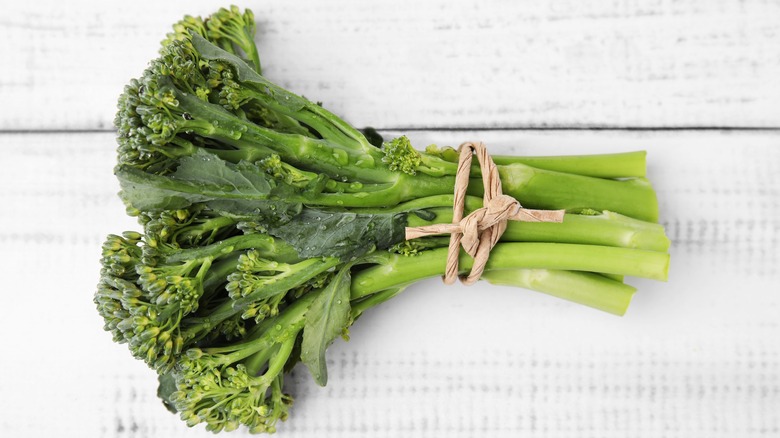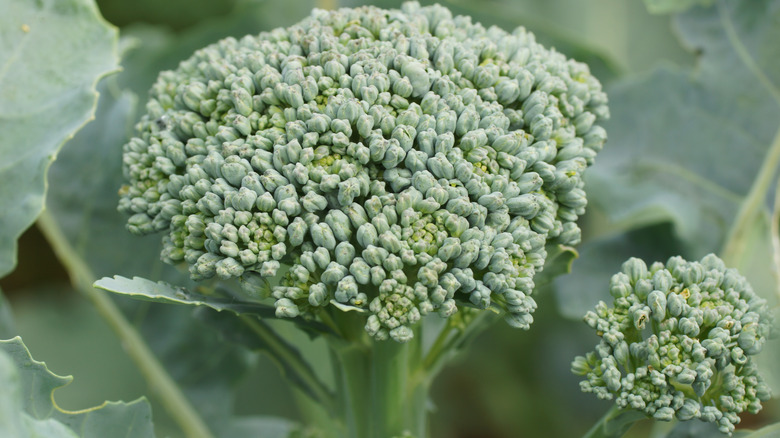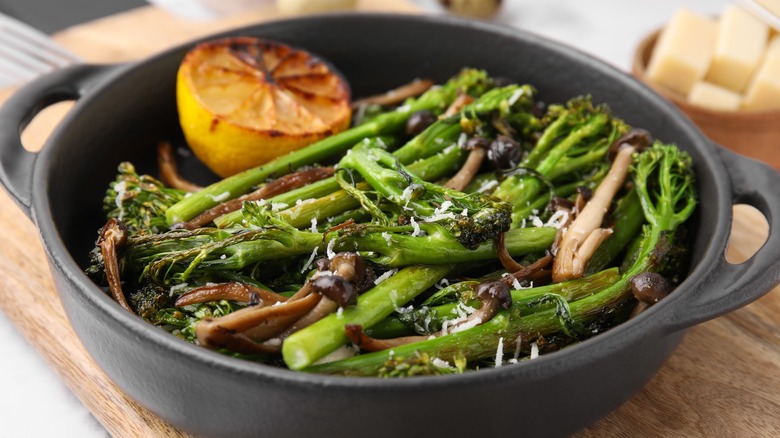Can You Cook Broccolini The Same Way As Broccoli?
"Broccolini" refers to a slender-stalked, loosely flowering, green leafy vegetable of the Brassicaceae family similar to its namesake, broccoli. Whereas broccoli can be eaten raw or cooked, broccolini is typically cooked, either whole or with the stems slightly trimmed. The entirety of the plant is edible, however, and can also be consumed raw to maintain its health benefits. Broccolini has a milder flavor than that of broccoli — and with thinner stalks, it doesn't take much to cook it through. So, can you cook broccolini the same way as broccoli? The answer is ... yes and no.
Often referred to as "baby broccoli," broccolini is not, in fact, small broccoli, but rather a hybrid of traditional broccoli and gai lan, a vegetable that is often referred to as Chinese broccoli or Chinese kale. Developed by a Japanese seed company in 1993, the plant first debuted in the U.S. in 1996 under its original name of "asparation." The unappetizing name was later changed to broccolini and trademarked in 1998 by Mann Packing Company of Salinas, California.
The differences between broccoli and broccolini
The differences between broccoli and broccolini are their physical appearances, tastes, and preparations. Broccoli has a large head and a chunky stalk, with large leaves flanking its extremities. Although entirely edible, the small clusters of the plant's tiny flower buds, known as florets, are the part most typically eaten. Broccoli is a cold-hardy plant, meaning it can withstand low temperatures and frosts. Broccoli's leaves have long been consumed, and Italian spigarello, a type of which many different kinds exist, is specifically grown for its leaves.
Similar to kale, spinach, kohlrabi, and other cold-hardy greens, you can use various cooking methods to prepare broccoli leaves, or you can serve them raw. Typically steamed, sautéed, or boiled, broccoli has a somewhat bitter taste, especially raw, however cooking staves off the bitterness and imparts a slightly sweeter, earthier taste.
In the same cruciferous vegetable category, broccolini is, by contrast, more slender, with lanky stalks, smaller florets, and less imposing leaves. Simple preparations, such as sautéed garlic broccolini recipes, are most common, with olive oil, copious amounts of garlic, lemon juice, and the possible addition of red pepper flakes. With a milder and sweeter taste, broccolini's flavors resonate well with roasting, as the caramelization that ensues brings out the plant's sweetness and earthy undertones. Sautéing renders less sweetness but allows for broccolini's unique flavors to sing. Similar to broccoli, broccolini can be steamed and its edible leaves are great cooked or raw.
Other ways to cook broccolini
Sautéing in olive oil with garlic remains the most common method of preparing broccolini. Variations on this theme include the aforementioned freshly squeezed lemon juice and red pepper flakes, but also try adding sautéed mushrooms, almond spears, and shaved cheeses, such as parmesan. Prep and cook times vary slightly, but expect no more than 10-15 minutes for both using this method. Ina Garten suggests blanching broccolini before sautéing it. This will further preserve the broccolini's vibrant green color, crispness, and freshly picked earthiness.
Roasting broccolini may require a bit more time depending on any toppings or additional ingredients to cook along with it. However, the roasting part is easy with a high temperature; it will generally run you about 15 minutes of cook time.
Whatever route you opt for, broccolini will certainly be a treat for your tastebuds to enjoy, whether it's steamed, roasted, sautéed, or raw.


